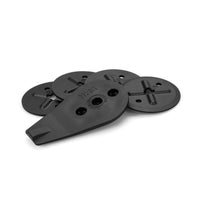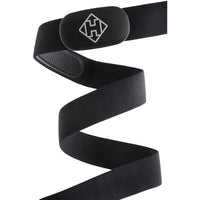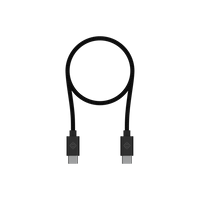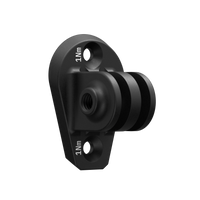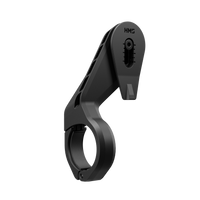Deciding Whether it’s Worth Buying a Dedicated Bike Computer vs. Using your Smartphone? Read On
Current smartphones feature incredible technology, from cameras to GPS mapping to computing power. With so many apps and options in the smartphone that you may well already have, is it worth getting a separate bike computer? Let’s look at the factors comparatively one by one: price, battery life, weather resistance, screen qualities, aerodynamics, accuracy, and more.
One other critical differentiator is durability; do you really want to have an expensive smartphone attached to your handlebars? Or would you prefer a purpose-built computer that can endure impacts and all sorts of weather? What happens when it rains?
With that leading set of questions put out there, let’s dig in.
Bike Computer vs Smartphone: Price
Bike computers range in cost from basic computers for $200 to the full-featured Hammerhead Karoo 2 for $399 up to the Garmin Edge 1040 Solar for $750. New smartphones can cost well over $1,000; the latest iPhone 14 Pro is $1,600, for instance. And of course those prices just include the equipment itself, not the cellular service.
This brings up another difference: most modern bike computers work on Bluetooth and WiFi, so you can upload your rides, download routes and workouts to use while riding, and update the firmware. Once you own a bike computer there is no cellular service fee.
On the plus side for smartphones, you can use a variety of cycling apps, many of which are free or have free versions. Many cyclists use apps like Strava or Ride with GPS to track and share their riders, and to create routes. While most cyclists use these apps before and after their rides, some riders also use them during their rides to record their data and in some instances get GPS guidance.
Another cost to consider is how you are mounting a bike computer versus a smartphone to your bike. All bike computers come with a stock mount to affix it to your handlerbar in a way that is safely visible while riding. You can buy aftermarket mounts that may be lighter or offer other features like a built-in light or action-camera mount, but most riders use the stock mount that is included with their computer. Smartphones, however, do not come stock with a bike mount. Quadlock is one option to mount your smartphone. It costs $60.
Bike Computer vs Smartphone: Navigation and GPS
Both modern bike computers and smartphones can do an excellent job of general navigation.
On smartphones, the ubiquity of Google Maps is no coincidence; being able to search virtually anything, anywhere and be given turn-by-turn directions in a manner optimized for cycling in less than a second is incredible. Google Maps can also reroute you if you change course part way through a route, and give you a realistic estimated time of arrival.
As good as Google Maps is, the software is fundamentally not cycling-specific, and sometimes suggested routes are not what a local cyclist would recommend.
Strava and Ride with GPS, however, are cycling-specific, and both offer excellent routing. Strava uses its heatmap for routing suggestions, based on millions of rides of actual cyclists. This allows you to select your destination and get a dependable route. You can also specify your route by selecting waypoints. For other cyclists, Ride with GPS offers a more robust route builder. Both offer turn-by-turn guidance, and routes from both can be used on a smartphone in their own app (fees may apply) and on a bike computer.
On bike computers, navigation properties vary by model. The most basic bike computers do not offer navigation, but simply record your data. Most modern bike computers offer GPS navigation, however, and cyclists use them in two main ways.
One common way to use a bike computer for navigation is to follow a route, whether that is created by you or a friend or someone else on an app like Strava or Ride with GPS. The best bike computers like the Hammerhead Karoo 2 automatically sync your routes from Strava and Ride with GPS and elsewhere, so all you have to do is select the route on your computer and follow the turn-by-turn directions on the color map.
Another way to use a bike computer for navigation is to use the on-board search functionality. This is less common and only available with higher end computers. On the Karoo 2, you can use the touchscreen to select a specific point on the map, and then the computer will generate a cycling-friendly route for you.
One cool feature that the Karoo 2 has is its CLIMBER feature, which automatically shows you upcoming climbs with color-coded gradients. This helps you not only navigate and prepare for upcoming turns but also regulate your effort based on the upcoming topography.
Bike Computer vs Smartphone: Durability
Smartphones are designed to be held in your hand, and transported in your pocket or purse. Bike computers are designed to be bolted to a bike that can be ridden over all sorts of terrain in all manner of weather.
If you drop your bike computer on concrete or rocks or any other rough surface, say, as you are walking into your house, it will almost certainly be fine. If you drop your smartphone without a protective case, you may well be in trouble.
A bike computer wins here.
Bike Computer vs Smartphone: Battery life
Battery life for both bike computers and smartphones have improved by leaps and bounds in recent years. But both categories still have wide variations based on model and the age of the product. That to say, it’s not a simple manner of saying one is better than the other.
With both groups, using navigation and other robust features definitely affects battery life, as does screen brightness.
For bike computers, battery life can last anywhere from just three or four hours to 12 or more. The same can be said of smartphones.
For the Hammerhead Karoo 2, battery life is between seven and 14 hours, depending on which features and settings are being used.
Bike Computer vs Smartphone: Weather resistance and functionality when wet
Many smartphones have a good amount of weather resistance built into them; your smartphone likely will not be harmed if it gets rained on. Bike computers are certainly designed to handle weather — and sweat.
One noticeable difference however is functionality when wet. Touchscreens are certainly handy for many situations, such as typing in words or numbers, navigating around on a map, or adjusting settings.
Sometimes on the bike, however, touchscreens are not ideal, and riding in the rain is chief among these times. Your smartphone will still show information, but try changing screens or typing when the screen is wet. The Hammerhead Karoo 2 has the best of both worlds, in that you can use the touchscreen or buttons on the side of the unit to control the unit.
Bike Computer vs Smartphone: Screen
Most smartphones have superior resolution and clarity to most bike computers, and with much larger screens. For cost and durability reasons, most bike computers are designed with lower resolution than smartphones.
The latest iPhone 14 Pro Max, for instance, has a resolution of 2,796 by 1,290 pixels. The screen is also more than 6 inches tall.
A better comparison to bike computer might be by pixels per inch, which is a whopping 460ppi on that iPhone 14 Pro Max.
For bike computers, the two best units in terms of resolution are the $399 Karoo 2 at 292ppi and the $599 Garmin Edge 1040 at 157ppi. Other bike computers have lower screen resolution.
The Karoo 2 is also built with an anti-glare screen that is built to withstand the rigors of cycling.
Bike Computer vs Smartphone: Aerodynamics
Gravity and air are the two main types of resistance against your forward momentum in cycling. The less aerodynamic resistance you and your bike generate, the faster (and easier!) you go for the same amount of physical output.
A bike computer is typically much smaller and therefore more aerodynamic than a phone, so it’s faster. Also, since bike computers are designed to be used on a bike, their respective mounts are often streamlined for visual and aerodynamic minimalism in front of the handlebar, whereas a phone bike mount is a much larger and sits on top of the stem or the handlebar, adding aerodynamic drag.
Bike Computer vs Smartphone: Accuracy
There are two families of measurement for cycling metrics between bike computers and smartphones: the things that the computer or phone itself measures, and the things that external sensors like a cadence sensor, a power meter, or a heart rate meter measure.
For the latter category, both bike computers and smartphones are simply monitors to display and record, but most smartphones do not work on the ANT+ frequency used by many cycling peripherals. An increasing number of heart rate monitors, power meters and even speed sensors now also work on Bluetooth, but older models do not.
For the first category of internal measurement, accuracy varies by unit, but is generally quite reliable for new smartphones and certainly for high-end bike computers. Smartphones and high-end computers have built-in GPS to measure and record speed, distance and routing.
High-end bike computers like the Hammerhead Karoo 2 also measure altitude through barometric sensors and ambient temperature, which smartphones do not.
Bike Computer vs Smartphone: Training
Both bike computers and smartphones can be used for training, but your options for smartphone-guided workouts are more limited, particularly if you want to integrate power measurement into your training.
High-end computers like the Karoo 2 can sync TrainingPeaks so your daily workouts pop up on your computer, where you can follow each interval step as measured by your power meter and/or heart rate monitor, in addition to the time duration.
In Conclusion
Smartphones are incredible pieces of technology that allow us to do a wide variety of things, from photography to video to researching information. Smartphones can also record the basics of a bike ride, and be used for navigation with the use of one of a few apps. Bike computers, however, are purpose-built for cycling and as such have better durability, more features, and better integration into both mounting on the bike and interacting with cycling technology like power meters.


